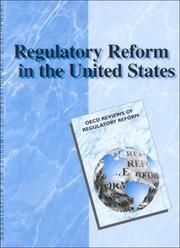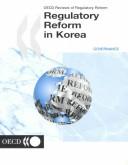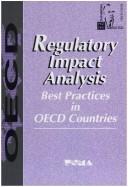| Listing 1 - 6 of 6 |
Sort by
|
Book
ISBN: 1280462809 9786610462803 0821364952 1423785509 Year: 2006 Publisher: Washington, D.C. : International Finance Corporation : World Bank,
Abstract | Keywords | Export | Availability | Bookmark
 Loading...
Loading...Choose an application
- Reference Manager
- EndNote
- RefWorks (Direct export to RefWorks)
This book describes the recent activities of the Foreign Investment Advisory Service (a joint facility of the IFC and the World Bank) to help governments in developing and transition economies to identify and remove administrative barriers to investment. Lessons learned include the critical need for political will to implement reforms, leadership from center of government, and capacity to ensure sound implementation of legislative and regulatory reform over an extended period of time, including regular monitoring and evaluation.

ISBN: 926417074X 9264173773 9789264170742 Year: 1999 Publisher: Paris : OCDE (Organisation de coopération et de développement économiques) = OECD (Organisation for Economic Co-operation and Development),
Abstract | Keywords | Export | Availability | Bookmark
 Loading...
Loading...Choose an application
- Reference Manager
- EndNote
- RefWorks (Direct export to RefWorks)
The Dutch experience in regulatory reform has vital lessons about the modernisation of the European welfare state and its integration into the European single market. Regulatory reform is the most recent element in the reshaping of the Dutch model. Following reforms to labour markets and the social welfare system in the 1980s, Dutch governments in the 1990s have sought a "new balance between protection and dynamism" based on competition policy, regulatory reform, and market openness. Today, the Netherlands ranks among the top OECD countries by many measures of economic performance, including employment growth. Though still in its early phases, regulatory reform has already produced major gains for the Netherlands in terms of competitiveness, flexibility, and consumer benefits. Yet major challenges are still to be faced. Some important reforms have been slow, indicating that the balance between domestic consensus-building and policy responsiveness is still being adjusted in the modern Dutch model. Further reforms in many areas will bring important gains in boosting the employment rate, improving sectoral performance, and providing social protection at lower cost. The Netherlands is one of the first OECD countries to request a broad review by the OECD of its national regulatory practices and domestic regulatory reforms. This report -- the result of intensive assessment by the OECD and review by its Member countries -- is unique in that it presents an integrated assessment of regulatory reform in framework areas such as the macroeconomic context, the quality of the public sector, competition policy and enforcement, and integration of market openness principles in regulatory processes, and in sectors such as electricity and telecommunications. The policy recommendations present a balanced plan of action for both short and longer-term based on best international regulatory practices.
Economic law --- Economic policy and planning (general) --- Netherlands --- Industrial policy --- Trade regulation --- Deregulation --- Economic policy --- Economic conditions --- Governance --- Management --- Industrial Management --- Business & Economics --- 462 Economisch beleid --- Nederland --- pays bas --- politique economique --- politique fiscale --- politique sociale --- concurrentie, internationaal --- economische groei --- economische politiek --- economische situatiebeschrijvingen --- handel, internationaal --- markt, internationaal --- OESO --- 338.9492 --- -Industrial policy --- -Trade regulation --- -Business --- Industries --- Industry and state --- Regulatory reform --- nederland --- economisch beleid --- fiscaal beleid --- sociale politiek --- Government policy --- Law and legislation --- -Economic policy. --- -nederland --- Economic policy. --- Ocde, pays de l' --- Pays-bas --- Politique economique --- Conditions economiques --- 20e siecle

ISBN: 9264170758 9264173986 Year: 1999 Publisher: Paris : OECD Publishing,
Abstract | Keywords | Export | Availability | Bookmark
 Loading...
Loading...Choose an application
- Reference Manager
- EndNote
- RefWorks (Direct export to RefWorks)
The United States has been a world leader in regulatory reform for a quarter century. Contrary to popular belief, the United States is not less regulated than other countries, but differently regulated due to the pro-competition policy stance of federal regulatory regimes, and the openness and contestability of regulatory processes. Far-reaching economic deregulation combined with efforts to improve the quality of social regulation have supported the construction of one of the most innovative, flexible and open economies in the OECD, while maintaining health, safety and environmental standards at relatively high levels. However, significant regulatory problems still exist. Improving the performance and cost-effectiveness of expensive social regulations and government formalities is a key challenge for regulatory quality. In a word, the challenge of regulatory reform in the United States is not how much regulation, but how good. The United States is one of the first OECD countries to request a broad review by the OECD of its national regulatory practices and domestic regulatory reforms. This report -- the result of intensive assessment by the OECD and review by its Member countries -- is unique in that it presents an integrated assessment of regulatory reform in framework areas such as the macroeconomic context, the quality of the public sector, competition policy and enforcement, and integration of market openness principles in regulatory processes, and in sectors such as electricity and telecommunications. The policy recommendations present a balanced plan of action for both short and longer-term based on best international regulatory practices.
Economic law --- Economic policy and planning (general) --- United States --- concurrence --- eua --- finances --- legislation economique --- reforme economique --- Trade regulation --- Deregulation --- -Industrial policy --- -338.973 --- Business --- Industries --- Industry and state --- Economic policy --- Regulatory reform --- Industrial policy --- concurrentie --- vsa --- financien --- economische wetgeving --- economische hervorming --- Government policy --- Law and legislation --- Economic conditions --- -Economic policy --- -concurrence --- U.S.A. --- Jungtinės Amerikos valstybės --- Soedinennye Shtaty Si︠e︡vernoĭ Ameriki --- Soedinennye Shtaty Severnoĭ Ameriki --- Si︠e︡vero-Amerikanskīe Soedinennye Shtaty --- Severo-Amerikanskie Soedinennye Shtaty --- Zlucheni Derz︠h︡avy --- USA --- US --- Arhab --- Ar. ha-B. --- Artsot ha-Berit --- ولايات المتحدة الامريكية --- Wilāyāt al-Muttaḥidah al-Amirīkīyah --- ABSh --- Amerika Birlăshmish Shtatlary --- ABŞ --- Amerika Birlăşmi Ştatları --- Forente stater --- Spojené staty americké --- Severo-Amerikanskie Shtaty --- Sjedinjene Američke Države --- Zʹi︠e︡dnani Derz︠h︡avy Ameryky --- Amerikai Egyesült Államok --- Yhdysvallat --- Verenigde Staten --- Egyesült Államok --- Hiwsisayin Amerikayi Miatsʻeal Tērutʻiwnkʻ --- Estados Unidos de América --- United States of America --- Fareyniḳṭe Shṭaṭn --- Artzois Ha'bris --- Estados Unidos da América do Norte --- SShA --- Soedinennye Shtaty Ameriki --- VSA --- États-Unis d'Amérique --- Vereinigte Staaten von Amerika --- Stati Uniti d'America --- Estados Unidos --- EE.UU. --- Stany Zjednoczone --- ĒPA --- Amerika Qūrama Shtattary --- Amerika Qŭshma Shtatlari --- SAD --- Saharat ʻAmērikā --- Hēnomenai Politeiai Amerikēs --- ZSA --- Mei-kuo --- Meiguo --- Mei guo --- ZDA --- Združene države Amerike --- U.S. --- America (Republic) --- Amirika Carékat --- Verenigde State van Amerika --- VS --- ولايات المتحدة --- Wilāyāt al-Muttaḥidah --- ولايات المتّحدة الأمريكيّة --- Wilāyāt al-Muttaḥidah al-Amrīkīyah --- Estatos Unitos --- Estatos Unitos d'America --- Ètats-Unis d'Amèrica --- Estaos Xuníos d'América --- Estaos Xuníos --- Tetã peteĩ reko Amérikagua --- Istadus Unidus --- Amerika Birlăşmiş Ştatları --- Amerika ka Kelenyalen Jamanaw --- Bí-kok --- Amerika Qushma Shtattary --- AQSh --- Злучаныя Штаты Амерыкі --- Zluchanyi︠a︡ Shtaty Ameryki --- Yunaeted Stet blong Amerika --- Yunaeted Stet --- Vaeinigte Staatn --- Vaeinigte Staatn vo Amerika --- Stadoù-Unanet Amerika --- Sŭedineni amerikanski shtati --- САЩ --- SASht --- Съединените щати --- Sŭedinenite shtati --- Америка (Republic) --- Amerika (Republic) --- Estats Units d'Amèrica --- Америкӑри Пӗрлешӳллӗ Штатсем --- Amerikări Pĕrleshu̇llĕ Shtatsem --- Stati Uniti --- SUA (Stati Uniti d'America) --- Unol Daleithiau America --- Unol Daleithiau --- Amerikas Forenede Stater --- Vereinigte Staaten --- Wááshindoon Bikéyah Ałhidadiidzooígíí --- Zjadnośone staty Ameriki --- Ameerika Ühendriigid --- Ηνωμένες Πολιτείες της Αμερικής --- Hēnōmenes Politeies tēs Amerikēs --- Η.Π.Α. --- Ē.P.A. --- Usono --- Unuiĝintaj Ŝtatoj de Ameriko --- Американь Вейтьсэндявкс Штаттнэ --- Amerikanʹ Veĭtʹsėndi︠a︡vks Shtattnė --- Ameriketako Estatu Batuak --- Feriene Steaten --- Feriene Steaten fan Amearika --- FS --- Stâts Unîts di Americhe --- Stâts Unîts --- Stáit Aontaithe Mheiriceá --- Steatyn Unnaneysit America --- Steatyn Unnaneysit --- S.U.A. --- Na Stàitean Aonaichte --- NSA --- Mî-koet --- 미국 --- Miguk --- Amerikayi Miatsʻyal Nahangner --- Miatsʻyal Nahangner --- -Deregulation --- 338.973 --- Governance --- Management --- Industrial Management --- Business & Economics

ISBN: 1280082623 9786610082629 9264181741 9264176632 Year: 2000 Publisher: Paris : OECD Publishing,
Abstract | Keywords | Export | Availability | Bookmark
 Loading...
Loading...Choose an application
- Reference Manager
- EndNote
- RefWorks (Direct export to RefWorks)
OECD's 2000 review of regulatory reform in Korea. It finds that at the end of 1997, Korea suffered one of the worst economic crises ever experienced by an OECD country. An ambitious programme of regulatory, financial, and structural reforms, among the most far-reaching efforts at reform of regulation undertaken in OECD countries, was key to the strong economic recovery in 1999 and 2000. This programme not only stabilised the crisis, but also helped recreate the foundations for future sustainable growth. The Korean experience can be useful to other countries seeking to boost market-led growth. Reforms now are moving Korea from a highly interventionist and authoritarian model of economic development to a market oriented and open model based on values of consumer choice, democracy, and rule of law. Yet the job is far from finished. The web of government intervention has been only partly reformed, and many important issues are still to be tackled. Consistent progress on regulatory reform will be crucial to sustainable growth in Korea for several years to come. Korea is among several OECD countries to request a broad review by the OECD of its national regulatory practices and domestic regulatory reforms. This Review presents an integrated assessment of regulatory reform in framework areas such as the quality of the public sector, competition policy and enforcement, and market openness. It also contains chapters on sectors such as electricity and telecommunications, and an assessment of the macroeconomic context for reform. The policy recommendations present a balanced plan of action for both short and longer-term based on best international regulatory practices.
Industrial laws and legislation -- Korea (South). --- Law reform -- Korea (South). --- Trade regulation -- Korea (South). --- Trade regulation --- Industrial laws and legislation --- Deregulation --- Law reform --- Law - Non-U.S. --- Law - Africa, Asia, Pacific & Antarctica --- Law, Politics & Government --- Industries --- Regulatory reform --- Law and legislation --- Industrial policy --- Korea, Republic of --- Commerce --- Industrie --- Déréglementation --- Droit --- Réglementation --- Réforme
Book
ISBN: 9264173714 Year: 1999 Publisher: Paris : OECD Publishing,
Abstract | Keywords | Export | Availability | Bookmark
 Loading...
Loading...Choose an application
- Reference Manager
- EndNote
- RefWorks (Direct export to RefWorks)
OECD's 1999 review of regulatory reform in Japan. It finds that regulatory reform is at the heart of Japan’s strategy for economic recovery and long-term growth. Identified as a priority by the Japanese Government as early as 1994, considerable progress in regulatory reform has already been made. But today it is essential that regulatory reform be deepened and accelerated. This report calls for a "sharp break" with the regulatory practices and doctrines of the past. Energetic measures, including both sectoral reform and reform of framework conditions, need to be adopted quickly to complete the transition from a state-led growth model, now largely ineffective, to a market-driven growth model, the only model capable of laying the foundation for sustainable competitiveness and prosperity in Japan. Japan was one of the first OECD countries to request a broad review by the OECD of its national regulatory practices and domestic regulatory reforms. This report -- the result of intensive assessment by the OECD and review by its Member countries -- is unique in that it presents an integrated assessment of regulatory reform in framework areas such as the macroeconomic context, the quality of the public sector, competition policy and enforcement, and integration of market openness principles in regulatory processes, and in sectors such as electricity and telecommunications. The policy recommendations present a balanced plan of action for both short and longer-term based on best international regulatory practices.
Governance --- Trade regulation --- Deregulation --- Industrial policy --- Management --- Industrial Management --- Business & Economics --- Japan

ISBN: 9264156038 9264162151 Year: 1997 Publisher: Paris : OECD Publishing,
Abstract | Keywords | Export | Availability | Bookmark
 Loading...
Loading...Choose an application
- Reference Manager
- EndNote
- RefWorks (Direct export to RefWorks)
This is the first report to look across the OECD membership at how regulatory impact analysis is actually designed and carried out. Concrete "best practices" are identified in areas such as improving the capacity of government to produce high-quality analysis, applying analytical methods including benefit-cost analysis, collecting data, and consulting with the public to ensure that estimates are realistic.
Sociology of policy --- Organisation for Economic Co-operation and Development --- Deregulation --- Industrial policy --- Trade regulation --- #SBIB:001.IO --- #SBIB:303H15 --- #SBIB:35H411 --- Bedrijfsleven 658:338 --- Concurrentie 339.137.2 --- Economische toestand 338.1 --- Kosten-baten analyse 658.012.125 --- OESO / OCDE / OECD 339.92OECD --- Recht 34 --- Regulering / deregulering 351.820 --- Regulation of trade --- Regulatory reform --- Commercial law --- Consumer protection --- Business --- Industries --- Industry and state --- Economic policy --- Methoden en technieken van de bestuurswetenschappen --- Beleidscyclus: voorbereiding (inclusief planning) --- Law and legislation --- Government policy --- Hulpwetenschappen --- politieke wetenschappen. --- Governance --- Management --- Business & Economics --- Industrial Management
| Listing 1 - 6 of 6 |
Sort by
|

 Search
Search Feedback
Feedback About
About Help
Help News
News